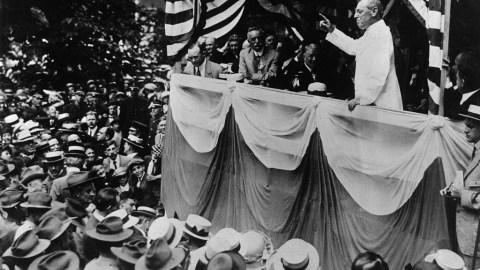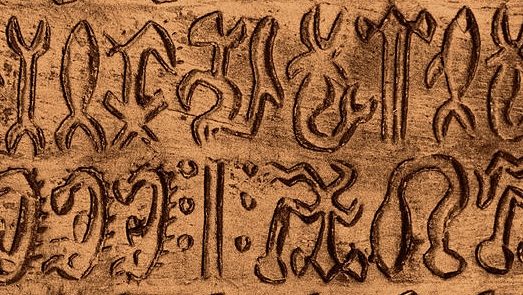How did a 100-year-old vision of global politics shape our future?

Photo by ullstein bild Dtl. / Getty Images
- America in 1919 was as divided as America in 2019. When President Woodrow Wilson introduced his vision for the League of Nations following World War I, he was met with criticism.
- With his reluctance to negotiate the functions of the League, Wilson failed to rally enough support.
- Whatever Wilson and the League's flaws, he revealed a path to new possibilities in global cooperation.
One hundred years ago, at the end of a 10,000-mile speaking tour to promote the League of Nations, President Woodrow Wilson delivered an emotional appeal that left his audience weeping. Wilson’s address in Pueblo, Colorado, would be the last speech of his voluble political career.
Wilson envisioned the tour as an extended graduate seminar. He would explain, in his professorial way, the logic and intricacies of the Paris Peace Treaty ending World War I. Frustrated by weeks of fruitless talks in Washington, where the Republican Senate majority was uniting to defeat the treaty, Wilson hoped his rhetorical marathon would create a new national consensus—and force reluctant senators to support Wilson’s vision of the League of Nations.
“What of our pledges to the men that lie dead in France?” Wilson asked, quivering as he addressed the Pueblo throng. “We said that they went over there, not to prove the prowess of America or her readiness for another war, but to see to it that there never was such a war again.”
Speaking of the mothers of the war dead, Wilson said: “They believe, and they rightly believe, that their sons saved the liberty of the world. They believe that wrapped up with the liberty of the world is the continuous protection of that liberty by the concerted powers of all civilized people.”
Moving on from World War I
The grueling September tour took Wilson from the Midwest (Ohio, Indiana, Iowa, Missouri, Nebraska, Minnesota), then to the Upper West (the Dakotas, Montana, Idaho), the Pacific (Washington, Oregon, California), and inland again (Nevada, Utah, Wyoming, Colorado).
Wilson failed. Even as he aroused great crowds, including 50,000 people at a San Diego stadium, the treaty opposition got stronger along the way. Majority Leader Henry Cabot Lodge and his Republican allies raised serious questions about American sovereignty, Japan’s takeover of a Chinese province, the prospect of a new arms race, and the failure to address the Irish question and human rights.
Americans supported the treaty, but not enthusiastically. Surveys of newspaper editors, party leaders, and civic organizations showed a willingness to try Wilson’s experiment, as long as American interests were protected. Mostly, Americans wanted to get on with their lives.
“I can predict with absolute certainty that within another generation there will be another world war if the nations of the world do not concert the method by which to prevent it.” – Woodrow Wilson
The end of the Western Tour
America in 1919 was as divided as America in 2019. In that fateful year, workers staged more than 2,000 strikes. Race riots and lynchings ripped apart cities and towns across the country. Nativism soared, with politicians attacking “hyphenated Americans” and vowing to restrict future immigration. Civil liberties were under attack. Hundreds of war opponents, including Socialist presidential candidate Eugene Debs and major labor leaders, were jailed under the Espionage Act for speaking against the war. Wilson’s postmaster general shut down even mildly critical newspapers and magazines by denying them access to the mail. Some 2,000 German-Americans were held in internment camps while German newspapers, schools, churches, and fraternal organizations were shut down. Ordinary Americans struggled to make ends meet with flat wages and spiraling prices.
The Western Tour ended early when Wilson suffered a physical breakdown after giving his speech in Pueblo. That would be the last time Wilson ever spoke in public. Days after returning to the White House, he suffered a major stroke that left him incapacitated for the last year and a half of his presidency. As his wife Edith managed the flow of visitors and information in the White House, Wilson was invisible. But he told Democrats to vote against alterations that would have soothed the concerns of many critics—and could have won the two-thirds Senate majority needed to ratify the Paris Peace Treaty.
Ever since then, historians have wondered: Could the League of Nations have prevented the rise of the Nazis and the Second World War?

Woodrow & Edith Wilson. Photo by Stock Montage / Getty Images.
In promoting the League, Wilson claimed that the new global body would prevent “98 percent” of future wars. Had it existed back in 1914, Wilson argued, the League would have prevented the spiral to global war after the assassination of Archduke Franz Ferdinand. The League, he promised, would prevent an even more destructive second world war.
But even if the League had created a new vehicle for promoting peace, it lacked sophisticated incentive structures that are necessary to shape behavior on the global stage.
The League was seen as a unitary world body. Like national governments, the League would include both executive (the executive council) and legislative (the general assembly) actors. Like a judicial body, the League would settle disputes between member states. Wilson usually rejected the idea that the League would be a “supergovernment,” but that’s just how most people envisioned it.
In reality, the League of Nations could have been anything. In supporting the League, Senator J.C.W. Beckham of Kentucky noted that the U.S. Constitution offered just a guide to the leaders of the new American republic. Only when people of good faith acted—starting with the Bill of Rights, Hamilton’s determination to pay the war debt, and landmark cases like Marbury v. Madison and McCullough v. Maryland—did that document gain real authority.
“I have loved but one flag and I can not share that devotion and give affection to the mongrel banner invented for a league.” – Henry Cabot Lodge
Even the greatest skeptics—at the Paris Peace Conference and in the U.S. Senate—supported creating some kind of global authority to set basic rules for behavior and then enforce those rules. Senator Henry Cabot Lodge and Theodore Roosevelt, the treaty’s biggest foes, had long argued for such an arrangement. Once begun, that version of the league could have evolved.
At the very least, the U.S. and other nations might have continued the work of Presidents McKinley, Roosevelt, and Taft and expanded the network of arbitration treaties. Those treaties obviously did not prevent the Great War, but they helped prevent war from breaking out in previous conflicts. The challenge was coordinating those treaties, making sure they did not create perverse commitments. The Great War had started, after all, when Austria-Hungary and Serbia called on their allies to back them in the conflict over the assassination of Austrian Archduke Franz Ferdinand. Because of a series of mutual-protection pacts, Germany, Russia, France, and Great Britain; later, Italy, Japan, and the Ottoman Empire joined the conflagration.
Even a weakened League of Nations could have led to something like the North Atlantic Treaty Organization. Beyond that core group of Western nations, it could have spun off a larger body to represent all of the world’s nations, like the United Nations, to address issues like colonialism, the environment, trade, and natural resources. Perhaps another body could set international standards for trade and finance, like the World Trade Organization.
Wilson’s fatal flaw was his unwillingness to see his vision as an experiment. Prideful and reluctant to negotiate, he considered the League a complete solution to global problems. But what if Wilson had been willing to accept a flawed League? What if he had been willing to bargain and compromise? What if he saw the League as an opportunity to experiment with different tools to prevent war and promote global cooperation?
Wilson’s stubbornness not only doomed his vision for a League of Nations. It also short-circuited the public debate about the most effective ways to foster global peace and cooperation.

Political cartoon of President Woodrow Wilson published by Bronstrup in The San Francisco Chronicle, circa 1919. Photo by Fotosearch / Getty Images.
But Wilson held fast to his singular vision of the League, which was originally drawn up by Jan Smuts, the soon-to-be prime minister of South Africa. The Smuts plan fit with Wilson’s Progressive mindset, in which technocrats manage conflict by asserting top-down control over public affairs. As the Smuts plan gained the assent of the Paris conferees, Wilson refused to consider alterations or alternatives.
However, there could have been a more nuanced approach to conflict resolution.
Lord Robert Cecil, for example, proposed an annual meeting of the heads of state of great powers. Every four years, the world’s nations would meet to adopt plans for preventing war and maintaining peace. This alliance could evolve, test which practices worked and which ones didn’t. Maybe, Cecil suggested, the League of Nations did not have to emerge whole, like Athena from the head of Zeus. Maybe the League could have tried different arrangements and incentives to see what worked best.
On the Western Tour, Wilson acknowledged that the League would evolve—usually to parry criticism about the League. Whatever the problem, Wilson promised that the League would rise to the occasion and address it. But in the thick of battle, Wilson stood firm by the covenant he brought home from Paris.
Overcoming the free rider problem
The challenge to any collaboration, of course, is the “free rider.” In any group, members seek to reap collective benefits while allowing others to make the sacrifices and pay the bills. The bigger the group, the easier it is for one or more free riders to evade their responsibilities.
Whether or not the U.S. joined, the free-rider problem would undermine the League of Nations. The League was organized along the familiar, old-fashioned ideas about sovereignty and power. Stated simply, both proponents and opponents of the League believed that authority is exercised from the top down, with sanctions to punish whoever defies the rules. Like most institutions in that day, discipline and punishment were the primary means of enforcing standards.
Consider the primary mission of the League: To prevent war. Under Article X, potential belligerents must agree to a 90-day “cooling off” period to hash out their differences. If one nation should invade another, the League would impose an economic boycott and then, as a last resort, take military action against that nation. Under Article XI, member nations were told to bring issues of aggression to the League of Nations—a version of “if you see something, say something.”
Over time, the League could have added other tools to its repertoire—not just sanctions (sticks) but also benefits (carrots)—to counter military aggression. With this broader repertoire, the League could develop more effective approaches to promoting public goals like peace, financial stability, free trade and oceans, fair labor standards, environmental protection, health, colonial development, and infrastructure.
Meeting certain basic standards for key priorities could have been the “price of admission” for engaging League of Nations members.
To combat the arms race, for example, the League could have taxed military spending that exceeded 1 or 1.5 percent of the nation’s Gross Domestic Product. Excessive levels of military spending could be taxed and the funds returned for investment in public goods. (In 2014, NATO members agreed to spend 2 percent of GDP on defense spending by 2025. The U.S. now spends 3.6 percent, the United Kingdom 2.1 percent, France 1.8 percent, and Germany 1.2 percent.)
That “club” approach, later championed by Yale Nobel laureate William Nordhaus, could have provided a strategy for engaging nations on war and peace—and, decades later, a strategy for addressing the existential threat of global warming. Nations that joined the “club” of reducing carbon emissions would enjoy free trade and other benefits, while countries that did not would face tariffs and other barriers. Would-be free riders would have both positive and negative incentives to contribute to a solution.
If the League had developed a critical mass—with such incentives that even rogue states would desire to enter into its orbit—it might have gained the capacity to entice and coordinate global action on important issues.
As it was, the League’s champions and foes understood the power of sanctions like boycotts and military action—but not subtler enticements and incentives. Their vision, alas, lacked the insights of today’s “behavioral economics,” developed by Nobel laureate Daniel Kahneman of Princeton, the late Herbert Simon, and others. Policy wonks in Wilson’s day also did not understand the “evolution of cooperation” and complexity theory championed by the University of Michigan’s Robert Axelrod.
The League’s top-down, sanction-oriented approach doomed it, no matter who joined and who stayed out. The League began operations in 1920, without the U.S., and had some minor successes. It collapsed after the 1935 Abyssinian crisis, when the League failed to get Italy to arbitrate its conflict with Ethiopia (then known as Abyssinia). The next year, Italian dictator Benito Mussolini created the Italian East Africa by merging Eritrea, Somalia and Ethiopia. His alliance with Hitler was not far off.

The Council of the League of Nations holds its first session on 16th January 1920 in the clock room of the Ministery of Foreign Affairs chaired by Leon Bourgeois. Photo by Photo 12 / Universal Images Group via Getty Images.
Why did Wilson fail?
Wilson’s Western Tour failed to rally enough support to force the Senate’s hand. Early in the tour, North Carolina’s Democratic senators, Furnifold Simmons and Lee Overman, announced they would not support the treaty without changes. Other senators followed suit. Throughout the tour, skeptics and supporters alike grew more dubious of Wilson’s master plan, especially when the president dismissed criticism as ignorant or unpatriotic.
“The future is what President Wilson must look to for his vindication,” Senator Henry Ashurst of Arizona said in the tour’s early days. “It may that 25 years from now, we will be saying, ‘Would to God we could have one moment of Woodrow Wilson.’ … But that is not true now and it will not be true by 1920, I’m afraid.”
The League failed, mostly because of Wilson’s inability to see that a more flexible approach could win supporters and also expand the League’s vision and authority. But whatever his and the League’s flaws, Woodrow Wilson pointed the way to new possibilities of global cooperation on matters of life and death.
Charles Euchner, who teaches writing at Columbia University’s Graduate School of Architecture, Planning, and Preservation, is the author of Nobody Turn Me Around: A People’s History of the 1963 March on Washington (2010) and a forthcoming book on Woodrow Wilson’s campaign for the League of Nations. He can be reached at charleseuchner@gmail.com.





